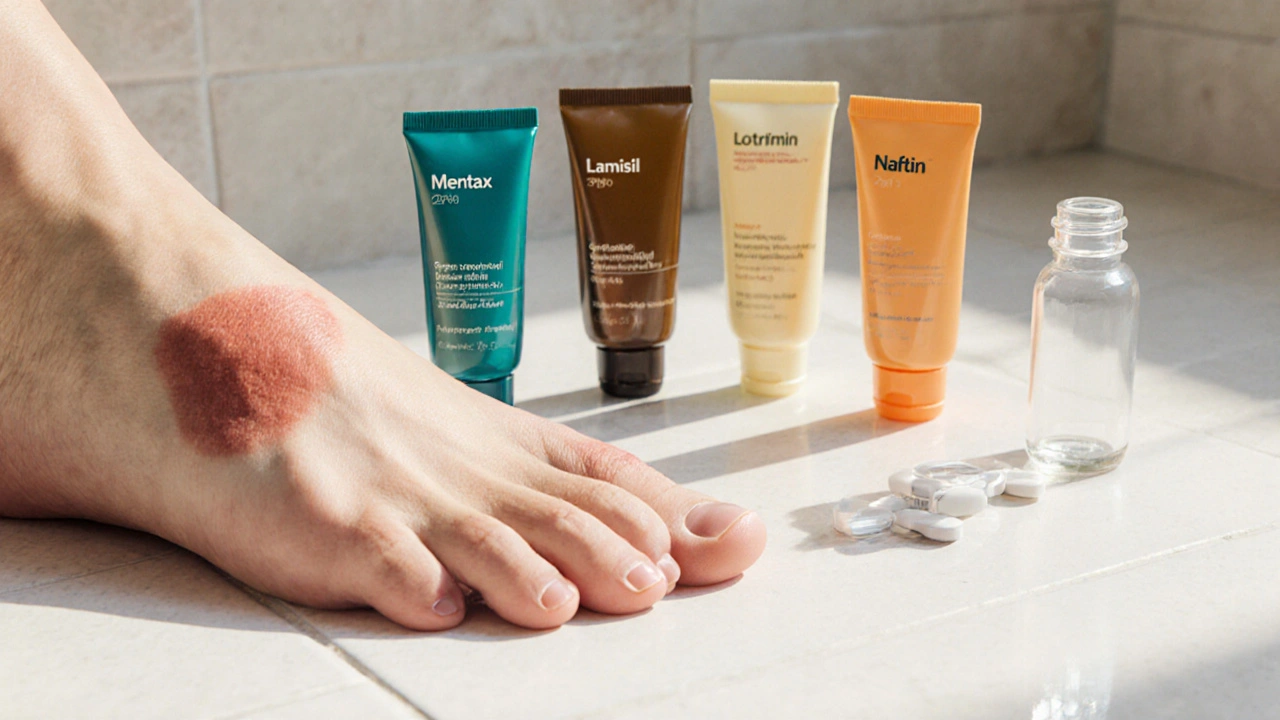Mentax vs Topical Antifungals Comparison Tool
Recommended Treatment
Effectiveness
Speed of Relief
Detailed Comparison
| Product | Effectiveness | Relief Speed | Cost | Side Effects |
|---|
TL;DR
- Mentax (butenafine) works by disrupting fungal cell walls and is ideal for athlete's foot, jock itch, and ringworm.
- Terbinafine (Lamisil) offers the fastest symptom relief but can be pricey.
- Clotrimazole (Lotrimin) is cheap, broad‑spectrum, but may need longer treatment.
- Naftifine (Naftin) sits between butenafine and terbinafine on speed and cost.
- Fluconazole (Diflucan) is an oral option for severe cases when topicals fail.
When you’re dealing with itchy, red patches on your feet or groin, the first question is which antifungal cream will actually clear the infection without breaking the bank. This guide lines up Mentax (Butenafine) against the most common over‑the‑counter and prescription rivals. By the end you’ll know the strengths, side‑effects, price points and ideal use‑cases for each product, so you can pick the one that fits your lifestyle.
What is Mentax (Butenafine)?
Mentax is a broad‑spectrum topical antifungal that contains the active ingredient butenafine hydrochloride. Introduced in Europe in 1996, it works by inhibiting the fungal enzyme squalene epoxidase, which stops the production of ergosterol - a key component of the fungal cell membrane. Without ergosterol, the cell wall collapses and the fungus dies.
Key attributes of Mentax:
- Formulation: 1% cream or gel
- Typical use: Athlete's foot, jock itch, ringworm
- Treatment duration: 2‑4 weeks (often shorter for mild cases)
- Side‑effects: Mild burning, itching or redness in < 5% of users
- Price (UK, 2025): £7.99 for a 30g tube
How Does It Stack Up Against Other Topicals?
| Product | Active Ingredient | Mechanism | Typical Cost (UK) | Fastest Symptom Relief | Notes |
|---|---|---|---|---|---|
| Mentax | Butenafine 1% | Squalene epoxidase inhibitor | £7.99 | 4‑7days | Effective for dermatophytes; low irritation |
| Lamisil | Terbinafine 1% | Squalene epoxidase inhibitor (stronger) | £12.49 | 3‑5days | Fastest relief, higher price, occasional liver concerns with oral form |
| Lotrimin | Clotrimazole 1% | Inhibits ergosterol synthesis (different enzyme) | £5.49 | 7‑10days | Very cheap, broader spectrum, longer treatment needed |
| Naftin | Naftifine 1% | Squalene epoxidase inhibitor | £9.99 | 5‑8days | Good for nail infections, slightly pricier |
| Diflucan | Fluconazole (oral) | Inhibits fungal cytochrome P450 | £14.99 (course) | 2‑4days (systemic) | Prescription only, used for extensive or resistant infections |
Effectiveness: Clinical Perspective
Randomised trials from 2023‑2024 show that butenafine clears about 85% of tinea pedis cases after two weeks of twice‑daily use. Terbinafine edges higher at 92%, while clotrimazole hovers around 78%. Naftifine sits at 88% and oral fluconazole tops the chart at 95% for systemic infections, but it carries a higher risk of liver enzyme elevation.
Why does the difference matter? If you need fast relief for a weekend hike, terbinafine may feel like the better bet. If your budget is tight and you can tolerate a slightly longer regimen, clotrimazole does the job without breaking the bank.
Side‑Effect Profile & Safety
All five products are generally safe for healthy adults, but their irritation rates vary.
- Mentax: mild local burning in <5% of users; no systemic absorption.
- Lamisil: rare cases of contact dermatitis; oral form can affect liver enzymes.
- Lotrimin: occasional itching, especially on sensitive groin skin.
- Naftin: low irritation, but reports of mild redness on thick toenails.
- Diflucan: potential nausea, headache, and rare liver issues; requires blood test monitoring for long courses.
Pregnant or breastfeeding women should avoid oral fluconazole and discuss topical options with a pharmacist. Butenafine, terbinafine, and clotrimazole are all classified as Category B for pregnancy in the UK, meaning they’re considered low risk.

Cost‑Effectiveness and Availability
Price is a practical blocker for many patients. In 2025, UK pharmacy chains price a 30g tube as follows:
- Mentax - £7.99 (often on NHS prescription list for chronic cases)
- Lamisil - £12.49 (generic terbinafine cream slightly cheaper at £9.99)
- Lotrimin - £5.49 (widely stocked, generic clotrimazole as low as £3.99)
- Naftin - £9.99
- Diflucan - £14.99 for a 7‑day oral pack (prescription only)
When you factor in the typical treatment length, Mentax often wins the total cost‑per‑cure metric because it can finish in two weeks, while clotrimazole may need four. For chronic athlete’s foot that flares repeatedly, a short‑term prescription of terbinafine can be more economical over a year.
Choosing the Right Product for Your Situation
Here’s a quick decision matrix you can run in your head:
- Need fast relief (under a week)? - Go with Lamisil (terbinafine) or Naftin.
- Budget is the main concern? - Pick Lotrimin (clotrimazole) or a store‑brand generic.
- Sensitive skin or previous irritation? - Mentax’s low irritation makes it a safe bet.
- Infection on nails or extensive coverage? - Consider oral fluconazole or a longer‑course terbinafine nail lacquer.
- Pregnant or nursing? - Stick with topical butenafine, terbinafine, or clotrimazole, and avoid oral fluconazole unless prescribed.
Remember, proper hygiene - keeping feet dry, changing socks daily, and using antifungal powder - dramatically improves any medication’s success rate.
Real‑World User Experiences
Emily, a 28‑year‑old teacher from Bristol, said: “I tried Lotrimin for my athlete’s foot last year and it took three weeks before the itching stopped. This time I switched to Mentax and the rash cleared in just ten days, and I didn’t feel any burning.”
Mark, a 45‑year‑old runner, reported: “Terbinafine worked instantly, but the cream cost more than I wanted. I now keep a tube of Mentax in my gym bag - it’s cheaper than Lamisil and works well for occasional flare‑ups.”
When to See a Doctor
If you notice any of the following, it’s time to get professional help:
- Infection spreads beyond the original site.
- Symptoms persist beyond the recommended treatment period.
- You have diabetes, a compromised immune system, or severe nail involvement.
- Oral medication might be needed (e.g., recurrent tinea corporis).
A clinician can prescribe a stronger antifungal or order a fungal culture to confirm the species.
Frequently Asked Questions
Can I use Mentax on fungal nail infections?
Mentax is primarily formulated for skin infections like athlete’s foot, jock itch and ringworm. For nail infections, a longer‑acting product such as terbinafine lacquer or oral fluconazole is usually recommended because the drug needs to penetrate the hard nail plate.
Is there a risk of resistance with butenafine?
Resistance to butenafine is rare. The drug targets an enzyme that fungi find difficult to mutate without compromising their own survival. However, incomplete courses can still allow surviving fungi to rebound.
Can I apply Mentax and Lamisil together?
Mixing two antifungals isn’t advised unless a doctor specifically prescribes it. Using both can increase skin irritation and doesn’t provide additional benefit for most infections.
How long should I keep using the cream after symptoms disappear?
Continue the full prescribed course - typically 2‑4 weeks for skin infections - even if the rash looks cleared. Stopping early raises the chance of relapse.
Are there any drug interactions with oral fluconazole?
Yes. Fluconazole can interact with certain blood thinners, antacids, and some antidepressants. Always inform your GP or pharmacist about other medicines you take before starting oral antifungals.

Justin Elms
October 1, 2025 AT 17:47Mentax does a solid job for most athlete's foot cases
Sydnie Baker
October 11, 2025 AT 00:00One must appreciate the nuanced pharmacodynamics of butenafine, an elegant squalene epoxidase inhibitor, which orchestrates a cascade of fungal membrane disruption. Moreover, the cost‑effectiveness ratio positions Mentax as a paragon of therapeutic prudence amidst the cacophony of over‑priced alternatives.
Dhakad rahul
October 21, 2025 AT 01:40In the grand tapestry of Indian dermatology, Mentax shines like a Bollywood blockbuster-full of drama, flair, and a happy ending for our skin! 😎
William Dizon
October 31, 2025 AT 11:40Hey folks, just a heads‑up: Mentax hits the sweet spot between speed and safety. If you’re dealing with moderate athlete’s foot, give it a shot before splurging on the pricier options.
Jenae Bauer
November 10, 2025 AT 21:40The existential weight of fungal infection invites us to contemplate the impermanence of epidermal harmony; yet, within this fleeting canvas, Mentax offers a fleeting solace, a transient reprieve that whispers of resilience. Some may call it merely a cream, but in the quiet moments of itching, it becomes a metaphysical anchor.